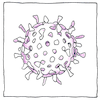Martinus Beijerinck
virology

|
Viruses
Smaller than a bacterium, immune to heat, immune to chemicals, not a toxin, and able to grow only in living cells, Martinus Beijerinck realized it was a soluable living germ, and named it virus.
Varieties
Beijerinck studied the tobacco mosaic virus. Friedrich Loeffler and Frosch found aphthovirus which causes foot-and-mouth disease. Frederick Twort discovered bacteriophages— viruses that infect bacteria. Scientists figured out how to grow viruses in the lab, which helped Jonas Salk create a vaccine for the poliovirus. Viruses are the most abundant biological entity on Earth, although many do not consider them to be a form of life because they do not have cells or their own metabolism. The smallpox virus has been eradicated, but yellow fever, measles, mumps and rubella, the herpes viruses, the Epstein-Barr virus, HIV, ebola, marburg, West Nile virus, hepatitis viruses, papillomaviruses, various influenza viruses and many others continue to plague us.
Viral death
Phocine distemper virus kills harbor seals; canine parvovirus kills puppies; foot-and-mouth disease virus kills cattle; classical swine fever virus kills pigs; lactate dehydrogenase elevating virus kills mice; simian haemorrhagic fever virus kills monkeys; bluetongue virus kills sheep, goats, buffalo, deer, camels, and antelope; deformed-wing virus kills honeybees. Even though they do not live as we do; we talk of killing viruses. Vaccines for viruses stimulate our immune systems; whose killer cells use enzymes to disassemble viruses.



Louis Pasteur suggested that the cause of rabies was a pathegen smaller than a bacterium. Normal microscopes can not see things that were as small as viruses. Wendell Stanley showed that viruses were particulate. Eventually, electron microscopes showed what they look like. Others isolated them with ceramic filters, crystalized them, and examined these with X-rays. We know now that a virus is a non-cellular structure with a core of DNA or RNA protected by a protein shell. Of the millions of different animal, plant, fungal, and bacterial viruses, only about five thousand have been described. A teaspoon of seawater contains about one million viruses (most harmless to plans and animals).
See also in The book of science:
Readings in wikipedia: